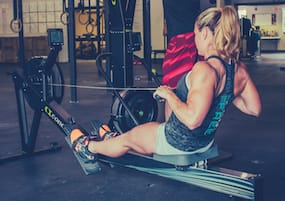Rowing is a natural motion and most people pick it up quickly with instruction and/or spending time focusing on technique. Have someone watch you row, comparing your body positions to those shown in the video below. Don't pull too hard until you are comfortable with the technique fundamentals.
The Rowing Stroke
How it works: The drive is the work portion of the stroke; the recovery is the rest portion that prepares you for the next drive. The body movements of the recovery are essentially the reverse of the drive. Blend these movements into a smooth continuum to create the rowing stroke.
The Catch
- Arms are straight; head is neutral; shoulders are level and not hunched.
- Upper body is leaning forward from the hips with the shouldersin front of the hips.
- Shins are vertical, or as close to vertical as is comfortable for you. Shins should not move beyond perpendicular.
- Heels may lift as needed.
The Drive
- Start the drive by pressing with your legs, and then swing the back through the vertical position before finally adding the arm pull.
- Hands move in a straight line to and from the flywheel.
- Shoulders remain low and relaxed.
The Finish
- Upper body is leaning back slightly, using good support fromthe core muscles.
- Legs are extended and handle is held lightly below your ribs.
- Shoulders should be low with wrists and grip relaxed. Wrists should be flat.
The Recovery
- Extend your arms until they straighten before leaning from the hips towards the flywheel.
- Once your hands have cleared your knees, allow your knees to bend and gradually slide the seat forward on the monorail.
- For your next stroke, return to the catch position with shoulders relaxed and shins vertical.
Did you know? Your breathing rhythms can affect your workout. With a little practice, you can relate your breath to your stroke. For tips on how to breathe while rowing, visit our Breathing Techniques page for more.
